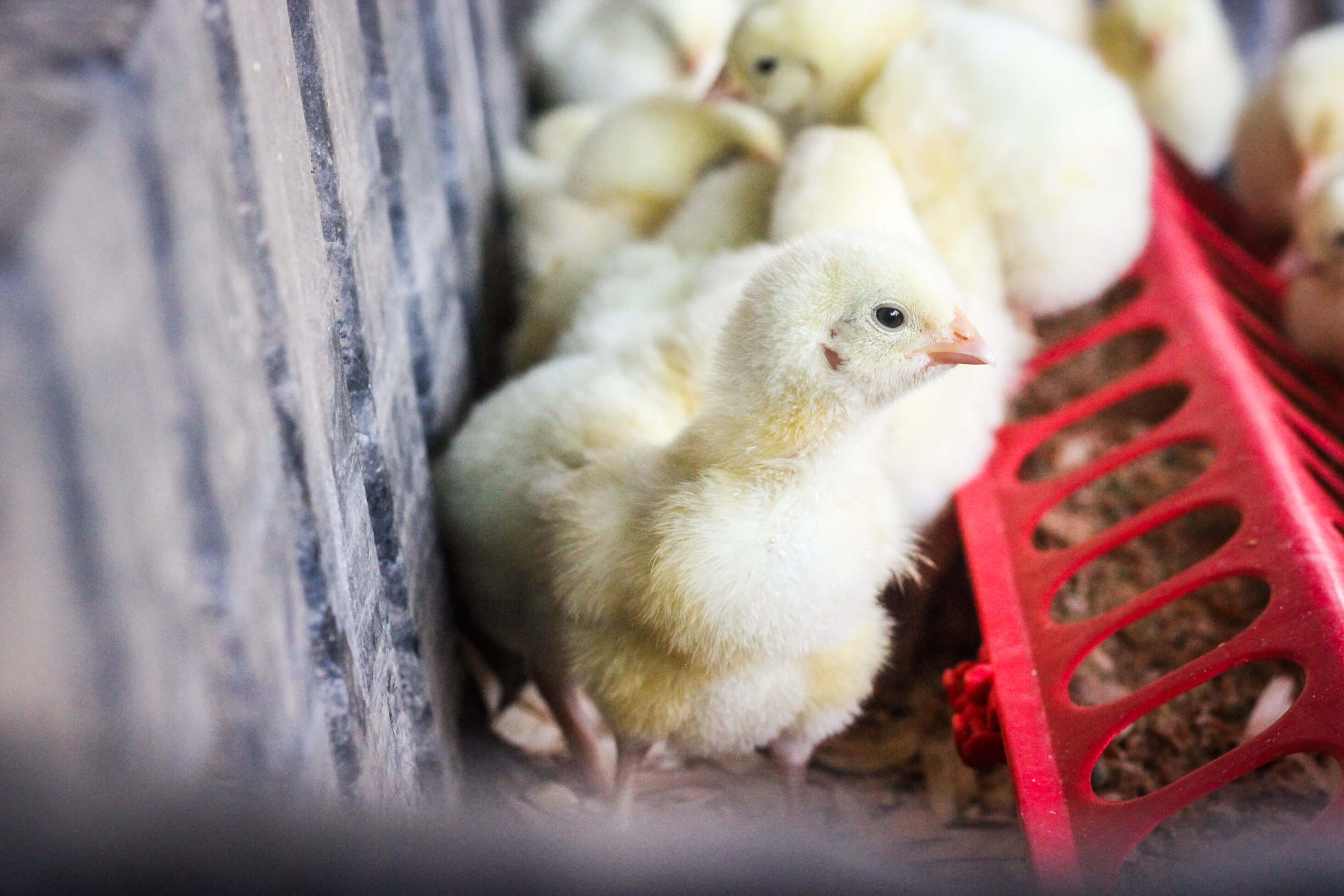
The dream is sustainability.
And as an urban farmer, raising meat chickens is one of the most sustainable things you could do, but also one of the most intimidating.
7 years ago when we decided to grow our own food, that meant we’d dive into gardening, goat milking, egg gathering, and yes, even chicken butchering. Gulp.
I’ll admit, I was pretty naive when we started. I figured raising meat chickens meant I’d raise some egg-laying hens and snatch one up ever once in a while for dinner.
Turns out that wasn’t exactly how it worked. Nope, not at all.
In my video below, I explain how we were able to raise a year’s supply of meat chickens right in our backyard and take you through the entire process, so be sure to watch!
Getting Started
For those of you itchin’ to get started with raising meat chickens (and for those of you a little queasy at the idea), let me share a bit of my wisdom with you. After years of raising our own meat chickens, we’ve learned quite a few lessons.
The first thing you need to know is that raising meat chickens is actually a seasonal thing. Most people will purchase a large order of 20-100 chicks from online hatcheries (yes, they actually get shipped to your post office), and raise them on their property anywhere from 9-16 weeks until they reach butchering weight.
You’ll really want to think about the best time of year to raise them is because when baby chicks are young, they aren’t that great at maintaining their temperature. If you purchase during the winter, it will be a lot more work for you to keep them warm. Most people will purchase meat chicks when the day temps are in the 90’s, then as the chicks grow and the weather gets cooler, the temperature is perfect for them. By the time it’s butchering day, the colder temps will make sure you don’t have lots of flies buzzing around during the job. Raising meat chickens is doable for any climate, you just need to plan for the best time.
Choosing a meat chicken breed
If you want to raise meat chickens, you’ll definitely want to choose a breed of chicken meant for meat because they grow faster than a laying hen and their energy production goes towards larger muscles instead of reproduction. The two main meat chicken breeds are the Cornish Cross and the Freedom Rangers. Red Rangers are very similar to Freedom Rangers and another less popular, but good meat breed is the Mistral Gris.
We’ve raised both the Cornish Cross and the Freedom Rangers, and in my video above you’ll see which I prefer.
Raising Meat Chickens
It’s really as simple as providing quality food & water, then making sure they stay healthy throughout their growing season. The cost of raising meat chickens is definitely on your side, especially if you’re trying to raise organic chicken. A whole organic chicken at the store might cost you $25, but you can do it yourself for $9 a chicken, which comes out to about $1.75/lb.
Finding the Best Feed
You’ll find that most people recommend you feed meat chicks a starter feed (about 22% protein), then move to a chick grower feed (about 20% protein), and finally finish with a chick finisher feed (about 18% protein). The problem with that scenario is that in order to feed a 22% protein, you’ll need to feed them soy. The last thing we want in our diets (or our chickens) is soy, so we purchase a feed that doesn’t have any, which means we feed an 20% protein for the first month, then move to an 18% protein feed for the rest of their lives. We purchase a non-GMO, no soy, no corn, with fishmeal, organic feed that we purchase from my local co-op here in Phoenix. There are a lot more options, so head on down to your feed store and see what you can find.
Temperature requirements
Baby chicks aren’t very good at regulating their temperature so you’ll need to provide a clamp & heat lamp to make sure they’re warm enough. They’ll need 95 degrees for the first week, 90 degrees for the 2nd week, and 85 degrees for the 3rd week. After that, they should be able to handle more variation in temperature. Just watch your chicks and if they’re cold, they’ll be huddling together.
Protection
Even if you live in the city, predators are a real threat. Owls & hawks are the biggest concern. In my video above, I explain the different types of protection and at which age you don’t have to worry about it anymore.
Preventing Health Issues
When you’re raising meat chickens, keeping their immune systems healthy is the key to preventing sickness. We do a few things to give their immune systems a boost.
- 1-2 TBS. of apple cider vinegar in their water.
- Oregano oil. (I mix 10 drops of oregano oil with 1 cup of water in a 2 oz. spray bottle, and then shake & spray on their food before feeding)
- Garlic cloves thrown in their pens weekly for them to peck at.
This year we had a few health problems pop up that could have definitely been prevented.
At week 5, we put our chickens on pasture that was too overgrown, and a few of our chickens got sour crop, which is where long pieces of grass gets stuck in their crop and ferments & causes digestive upset. We’ve never had this happen before and I’m sure it was due to the overgrown grass. Next time I’m going to make sure we put them on shorter grass.
In the video below, we got lucky and were able to help these 2 chicks recover naturally from sour crop.
At week 7, we had a few chickens develop bumblefoot, which is a condition where they get a store on their foot from getting an abrasion & walking over their droppings throughout the day. I’m positive the cause of this was from our wood chips we laid down in the feeding area. They were large and abrasive, and we should have put something softer like pine shavings down instead. I think this is why using a chicken tractor works so well. It forces the chickens on to a new area each day which greatly reduces the chances of bumblefoot. Even though we let them explore our entire pasture, they liked to stay around the food, which was over the wood chips.
Butchering Day
When you have a lot of chickens to butcher, you can either invite people over to help and make a day of it, or you can do a little at a time, like we did. This year, it was much easier for us to butcher ten in the morning, and do that for a week or so until they were done!
After you butcher, you’ll need to age the fresh birds in loosely wrapped bags in your fridge for 2-5 days. It might sound weird, but this tenderizes the meat and is a necessary step before you freeze them. When you have a lot of chickens to butcher, this is another reason why you should space out the butchering over a couple weeks so you have enough room in the fridge to store them.
Storing a Year’s Supply of Chicken in your Freezer
After we aged the chicken for 2-5 days in the fridge, they were ready to vacuum pack and freeze. We love vacuum packing our chicken, because this way we’ve had it last us for 2 years in the freezer! We used a food saver and it’s totally worth the cost in our opinion.
We also cut off the wings before we vaccum packed the whole chickens so we could have bags of wings for an easy dinner of bbq or hot wings:)
It’s so rewarding to know you’ve got chicken stored up for an entire year, and it’s honestly doable for anybody. As long as you can commit to 10 minutes a day for feeding & watering, you can have the dream of becoming self-sustainable with a year’s supply of meat. All it takes is some planning & commitment to be successful in raising meat chickens!
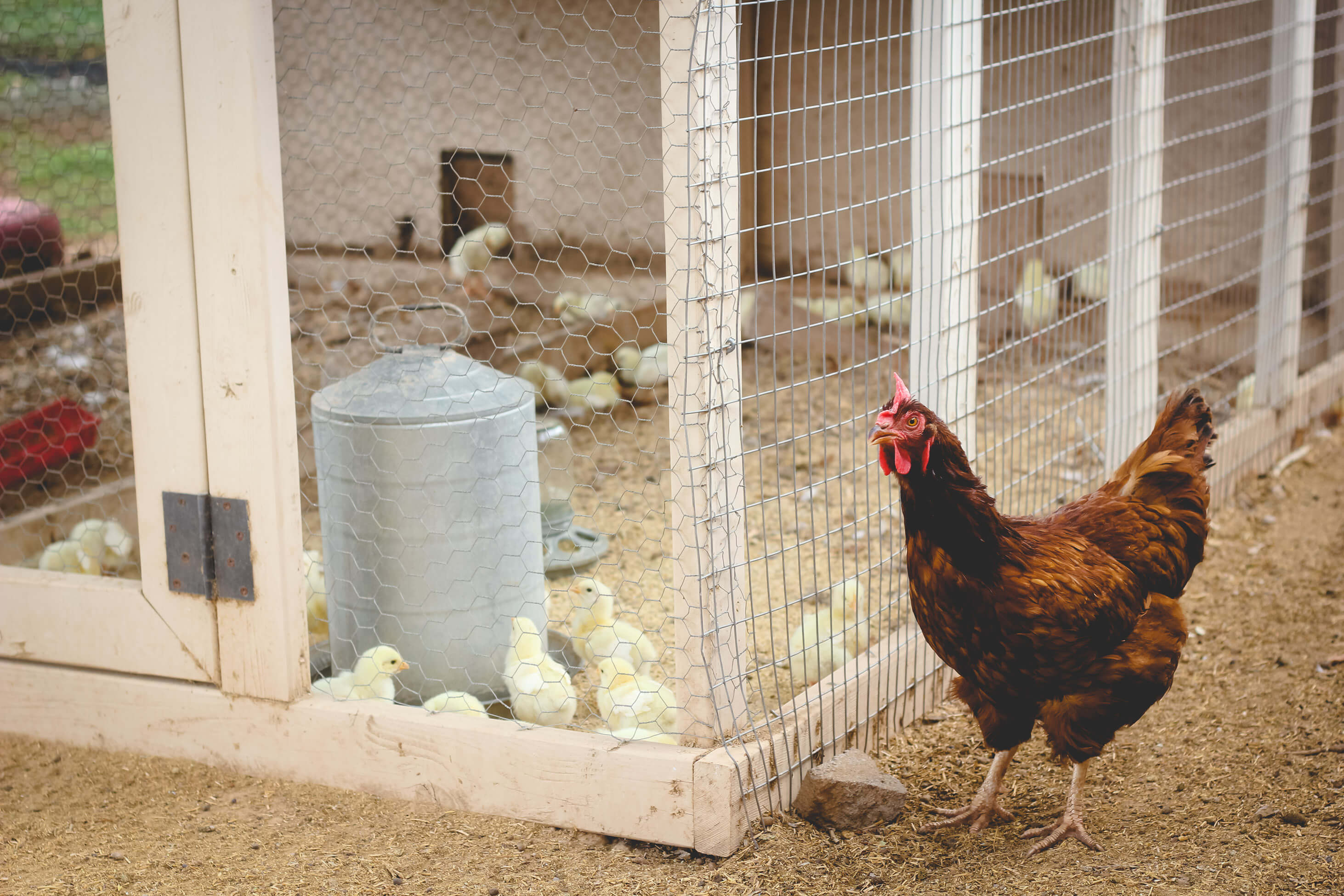
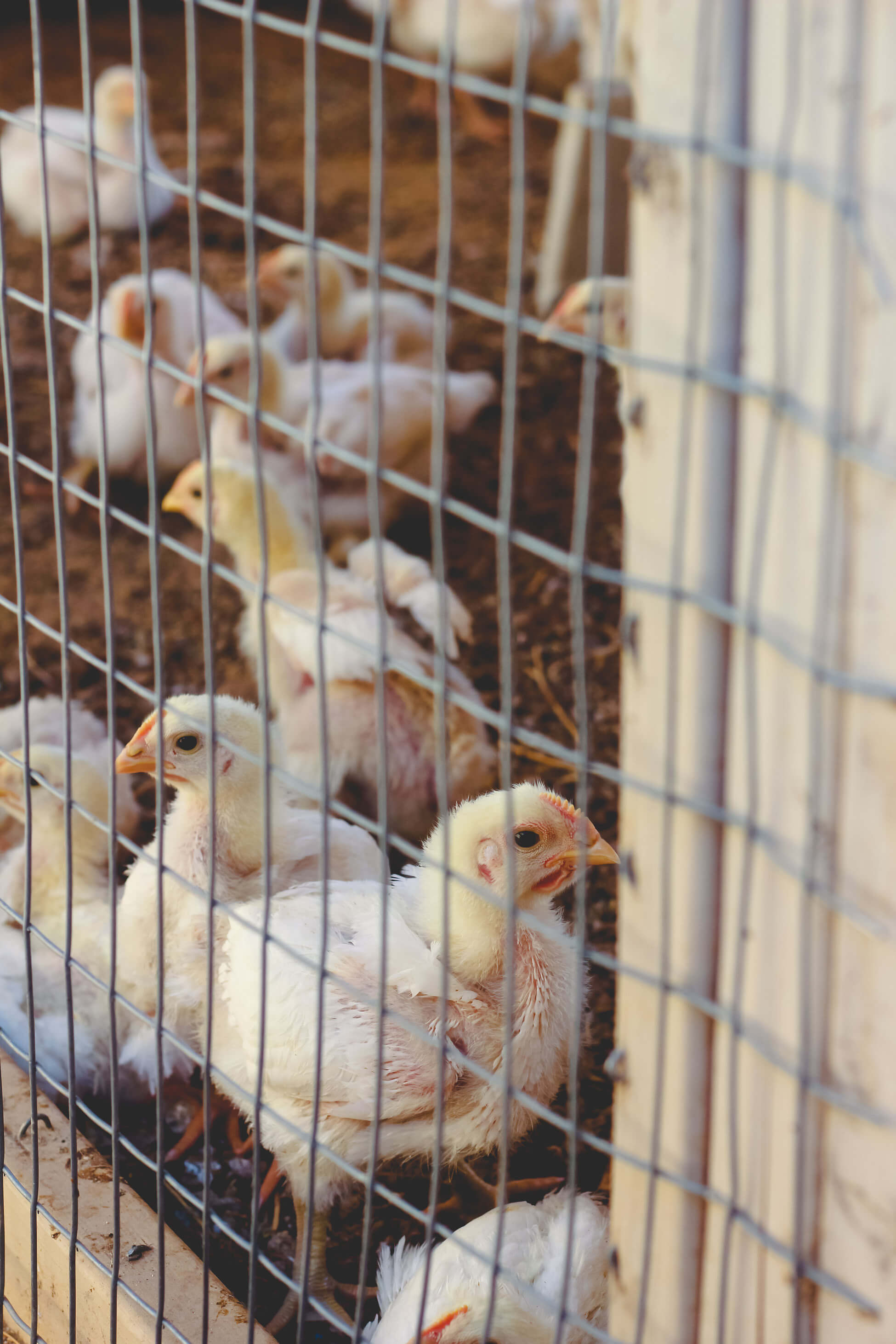
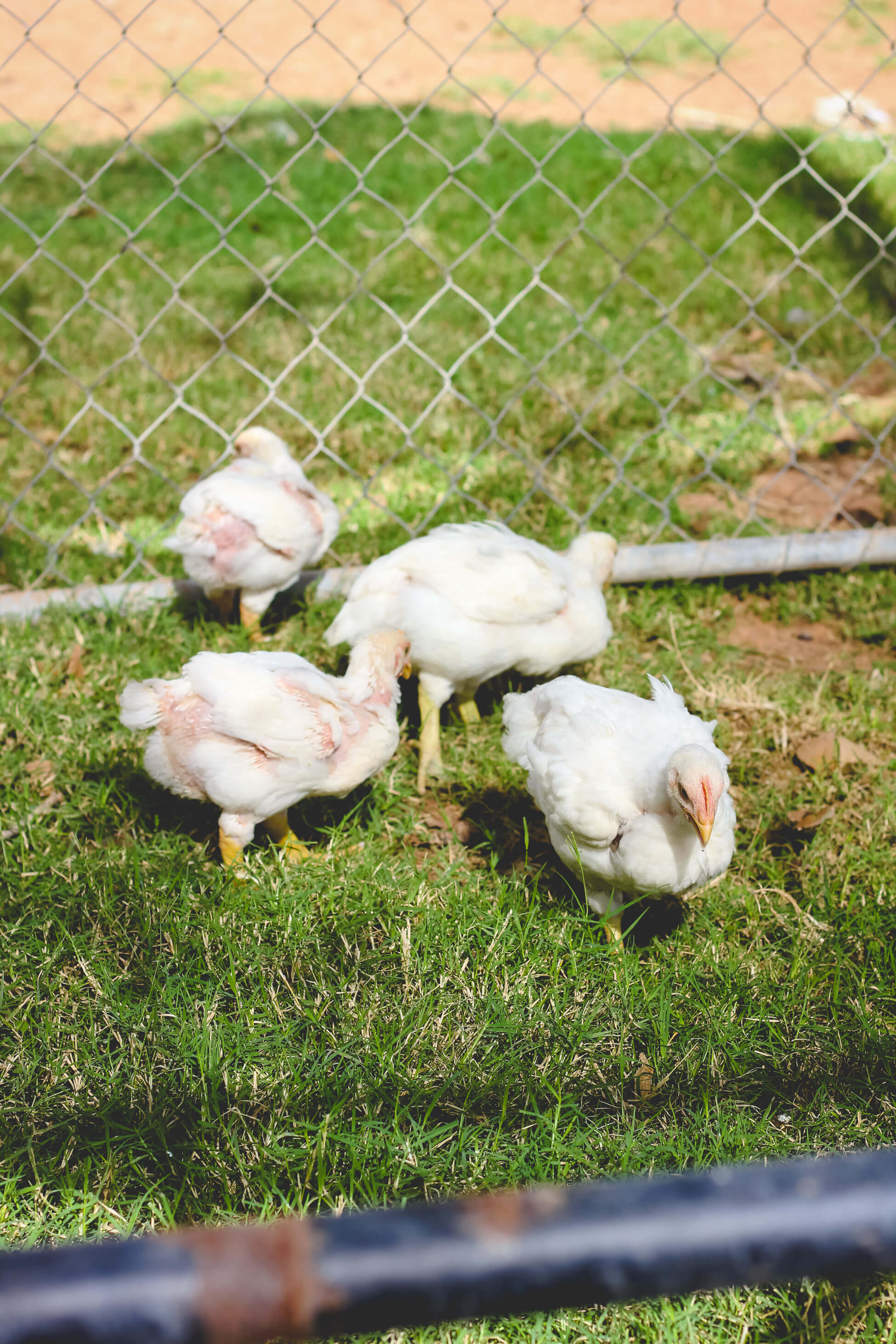
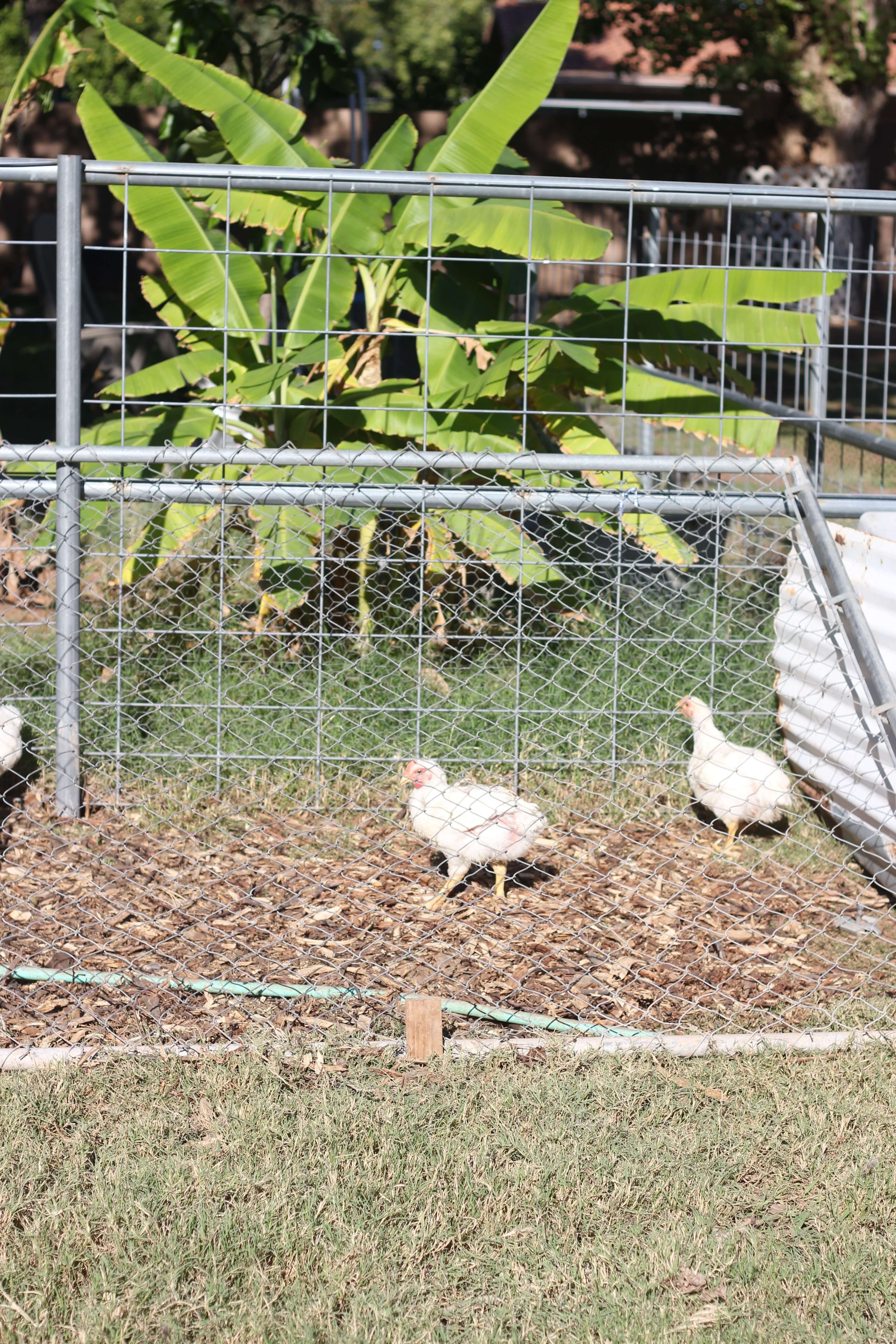
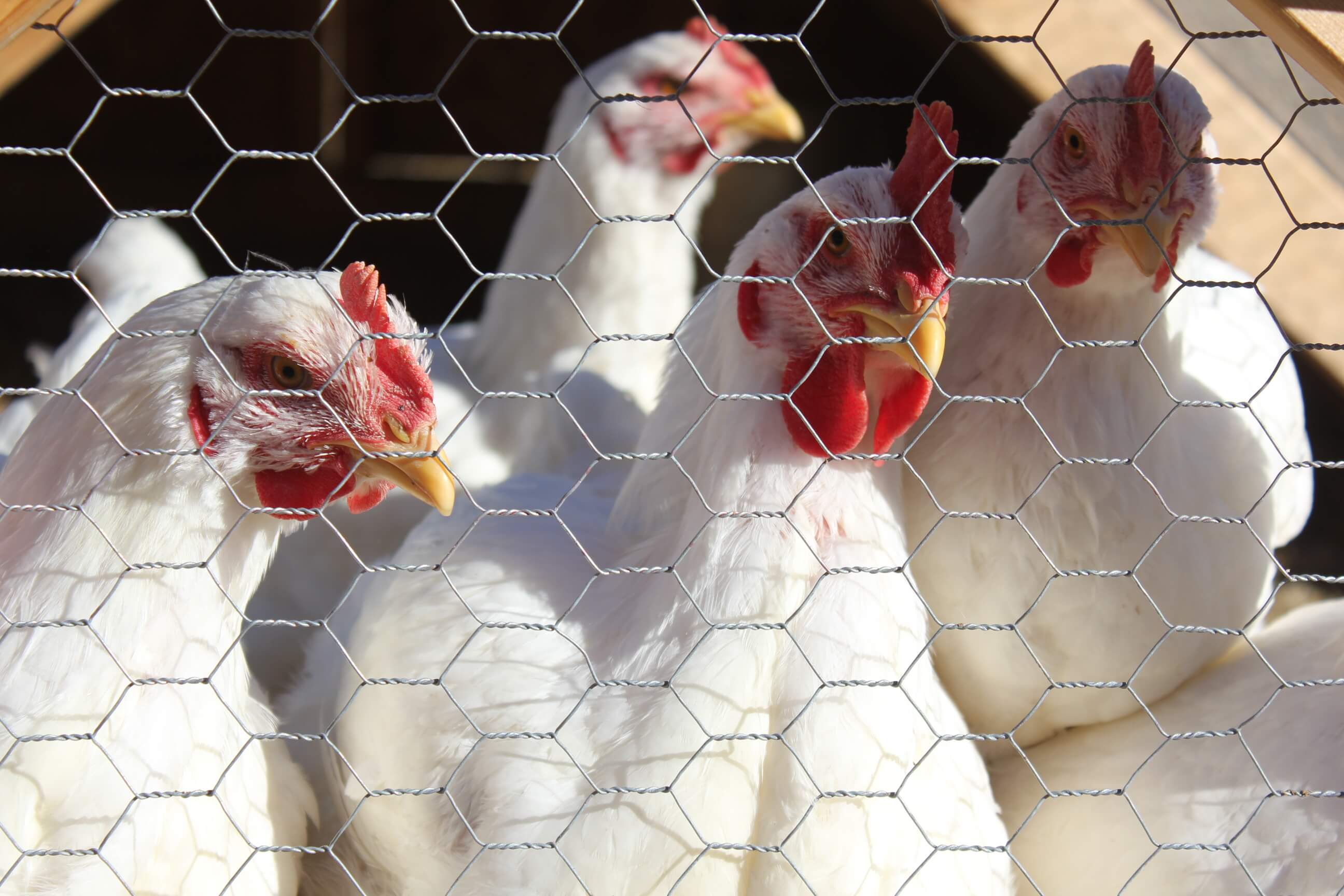
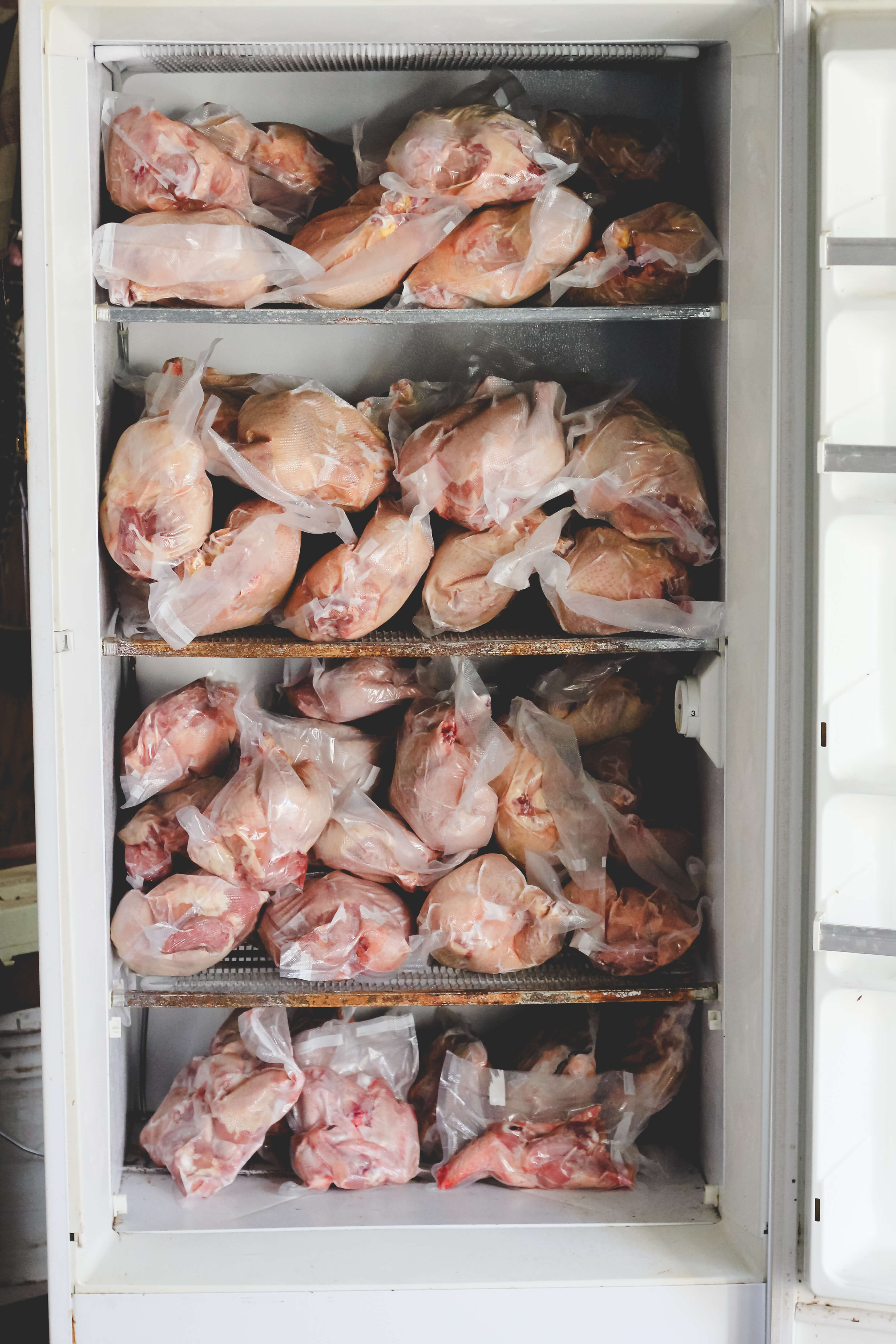
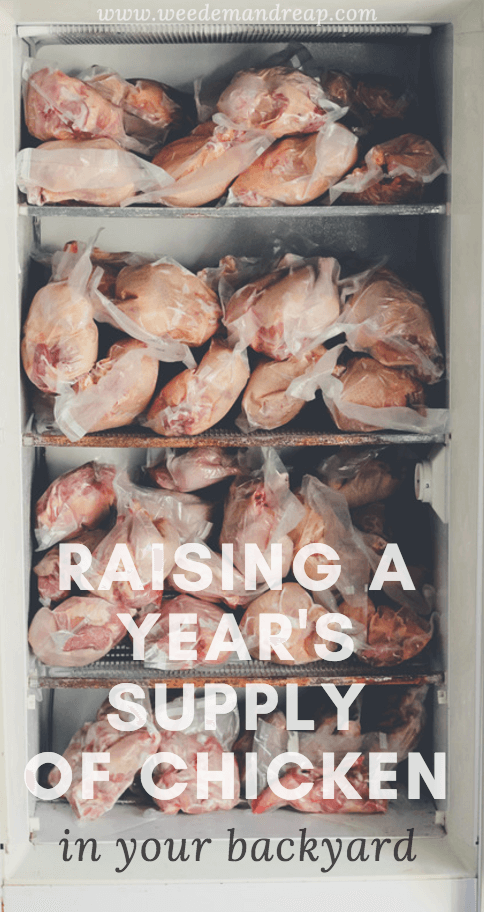
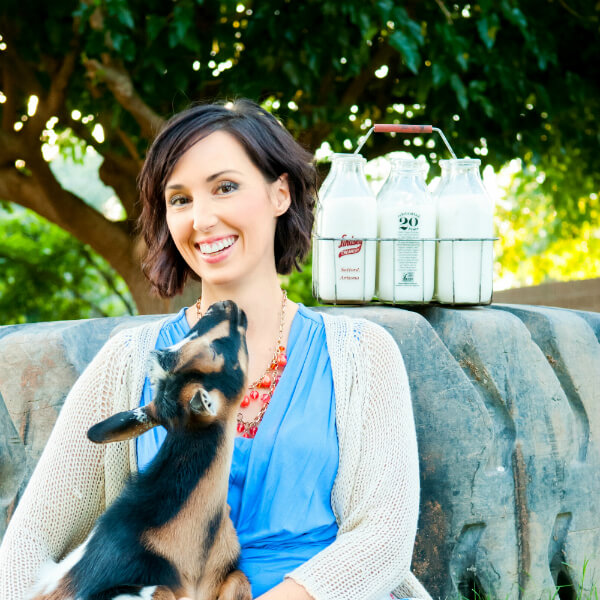
Instead of letting them age in bags in the fridge, we did coolers of ice water for 2 days. What is your opinion? We have just started out this week and have butchered 5 of 10. Thank you so much for the video on processing them too!
Hi Erin-
DaNelle finds the fridge is the best option for their processing, but yes, I’m sure the coolers would work, although have not used that process before. Glad it works for you!
Thank you -Bobbi (DaNelle’s Assistant)
Hi DaNelle – REALLY GREAT info, especially about time of year to raise and butcher (I also live in AZ), and organic chicken healthcare! One question: where can I get plans for that KILLER washing machine chicken plucker?! Thanks! Brian
Hi Brian-
This article and the embedded video will give you information on Kevin’s Crafty Chicken Plucker: https://www.weedemandreap.com/chicken-plucker-quickest-option/
I hope it works for you!
Thank you -Bobbi (DaNelle’s Assistant)
Hi! I have ordered some chickens from a small local farm and they will be butchered this weekend. What all do you save from the bird? I want to make sure I get the most out of this. Also, how do you typically prepare/use your chicken liver to get the vitamin K. Thank you!!
Hi Anna-
That’s awesome you are butchering the chickens yourself!
When butchering chickens, I typically save the gizzards and livers, as well as the neck. I cook the gizzards and livers to eat and save the neck for when I am making broth. Chicken livers only have about 3 micrograms of Vitamin K (~3% of the RDI). The dark meat of the chicken and egg yolks are a better source of Vitamin K. To add some additional Vitamin K to the chicken livers I cook them in grass-fed butter. Here is my favorite recipe for that: https://www.marksdailyapple.com/grilled-chicken-livers-with-herb-butter/
I like this recipe too for when I want to spice them up: https://www.marksdailyapple.com/cajun-blackened-chicken-livers-with-lemon-and-garlic/
I hope that helps! Best of luck!
Thank you -Bobbi (DaNelle’s Assistant)
Thanks for sharing your experiences! Do you wrap the fresh birds in paper or plastic for aging?
Hi Rebeca-
DaNelle prefers to wrap them in plastic. Thanks -Bobbi (DaNelle’s Assistant)
Id really like to know a few things sort of related to this operation you have going on because I hope some day to have a very similar set up. First I was wondering if you know about what percentage of your vegetables and such you grow yourself in your garden? And I was also wondering how you care for your lawn around the animals and such, i.e. what kind of grass do you keep and how do you maintain it or mow it? Also, is it inconceivable that you would grow multiple chicken breeds at once for meat? And finally I would like to know if you think it would be feasible to also raise rabbits alongside your free range chickens, since you also have tons of other animals? Thank you for taking the time to read my many questions, I see what you do in your life and get all dewy eyed about my own future. Youre really living the dream and showing that its possible for anyone, even people like me to do as well.
Hi Lucy-
Thanks for the kind words and all the great questions. DaNelle actually just put together 2 great Q&A videos that will address much of this.
https://www.youtube.com/watch?v=9eEBmpsgm88
https://www.youtube.com/watch?v=d7i34N4S1nk
I hope these help and I wish you the best of luck in all you endeavors! Thank you -Bobbi (DaNelle’s Assistant)
Thanks so much for your video and post. I watched it twice and processed my first bird, a rooster we can’t keep, today. Looking forward to trying 6 or so meat birds in the spring.
Hi!
Thanks for all of the great information that you share. We have egg layers. It I am considering meat chickens. I am sorry if I missed this somewhere, but how many chickens did it take for a whole years worth of meat? I know I heard 50 at some point. We are a family of 4. Thanks!!
Hi Raven-
That’s great you are considering raising your own meat chickens!
As for the number of chickens raised for a years worth a meat, 50 is a good number. In this video DaNelle has: https://www.bing.com/videos/search?q=weed+em+reap+meat+chickens&qpvt=weed+em+reap+meat+chickens&view=detail&mid=A6D949EFC89D9E77B6F1A6D949EFC89D9E77B6F1&FORM=VRDGAR
she does mention that for that year she did raise 50. She also talks about the differences in breeds and growth rate.
In her article on the cost of raising mention chickens: https://www.weedemandreap.com/raising-meat-chickens-cost/
she mentions that 30 heirloom freedom rangers produced about 76 pounds of meat.
It really depends on how much chicken meat your family eats as to how many you need. However, if that’s a bit difficult to calculate, 50 can be a good number to start. Although, if you are new to the game of meat chicken raising, starting out small might work better, say with 10-20, until you get the hang of it.
I hope this information helps! Best of luck! -Bobbi (DaNelle’s Assistant)
Great article!
We are moving to the country and planning on raising meat chickens. Do you only freeze your chickens whole (besides taking of the wings) or do you ever brake them all the way down? Is it easier to leave them whole and brake them down when you are ready to use them? Also, I plan to can a lot of chicken. What size jar would accommodate a whole cornish x ? Thanks!!
Hi Jenn-
That’s really great you are moving out to the country and raising meat chickens!
When it comes to freezing chickens, you can freeze them whole or cut them up. I do like cutting them up so when I take them out of the freezer they are ready to fix. However, cutting them up before freezing can be time consuming and a little tiring if you have a whole lot to do at once. So based on how many you are slaughtering, and your time commitment up front, you can decide if you want to freeze them whole or cut them up.
If I am pressure canning chicken, I take out the bones and just can the meat. So jar size is whatever you want to use.
If freezing in a jar make sure you use wide mouth, straight (no) shoulder jars. Be sure to leave 1 inch head space to accommodate expansion. So look at the size of hen you get after slaughtering, as chickens can be different sizes. Use a jar that fits the hen and allows for some space.
I hope this helps and best of luck. Thanks for reading and posting! -Bobbi
Thanks, DaNelle. This is really helpful.
I am 4 weeks into raising my first batch (13). So far so good but I probably won’t do the cornish again. Have to look for a better way to do this.
Hello! Can you just put them with your laying hens after there big enough?
Yes, you can:)
Thank you for the great post! I was wondering what you do with all the leftover bits? Feathers, offal and heads.
Thanks!
We toss the feathers & heads, but keep the offal for broths & soups.
I use the feet in making broths. Some of my next batch our local Chinese Restaurant will show me how they prepare them for consumption.
Liver my daughter loves in spreads. Gizzards and hearts ground twice then used in chili and other long cooking preparations.
Hey DaNelle, I’m hoping you can help me. I’ve gone to your grain co-op’s website and requested an order form multiple times but never receive anything in my email! We’re getting chicks in March and I’m desperate for an affordable, organic, soy-free feed. Is there a better way to contact them or request a form? I’m in Tucson but it says they are here as well.
Yes! There’s a facebook page here: https://www.facebook.com/BackyardChickenFarmersUnite Try messaging them over there:)
the only thing that I do different. Is as soon as the chicken is picked and cleaned I cool them off as fast as possible. I keep gallon milk jugs full of ice in the freezer. Making sure I have plenty. Place four of five in an old round tub and fill it full enough to throw the chick in to cool off fast. I also keep plenty of bleach water handy to clean equipment as I work. I also dip my chicken in a mild bleach water and rinse them the cooling tub. I never age the chicken as explained above. The fast cooling provides tender chicken for me. I will try a few with your aging plan and see what happens.
Nice articular enjoyed reading it.
<3 this article!
We decided to buy chickens this spring starting off with laying breeds. I accidentally ended up with a few too many roosters which went into the freezer. With the roos, we took them somewhere to be processed and paid a whopping $3 a bird!
I decided that I wanted to try cornish x for the first time after seeing how little meat we got from the roos which seemed pretty large before we took them for processing. Randomly while trying to prep myself for the deed, I came across your youtube video showing how to process meat birds. It was amazzzzing. I literally was rewinding and fastforwarding while cutting on the chicken. Next year I'm ordering enough to only eat our own chickens! Cornish x are for sure worth it as compared to heritage breeds IMO!
Love your videos, great job! I’ve raised and processed several meat birds over the past 5 years and like you say they are a messy bird and can be quite smelly. As for the processing I found that the dunking can be quite unpleasant also which I thought was the worst part of the process until I saw a video that mentioned putting some dish washing liquid in the scalding water. After watching the video I decided to try it the next time I processed and found it almost totally eliminated the foul smell and it also seemed to help make the plucking a little bit easier if doing it by hand. You would think the soap would effect the meat but with all the rinsing and cleaning you would never know soap was used. BTW, I love your plucker!
Love this! We started with meat birds this past spring and started with 11. For our first time butchering them, we tried six at a time! It was a whirlwind. Totally recommend if you are butchering chickens for the first time to start with 2-3. Six was a bit much plus we didn’t start early enough in the morning and the sun was rising quickly and hot! This year we plan to do something similar to you. Raising enough birds to last the entire year. It always seems like a lot but when it comes time to cook with chicken throughout the year it is something many people do not realize how much chicken they really do cook with.
Hi Danelle,
First, Merry Christmas and new year wishes!
2 years sounds way too long for dead meat, in spite of the technological advances we have in freezing and preserving. How feasible or difficult is it to space out the chicken butchering over a season, such that you get fresh meat whenever you want, rather than storing them for long. I’d prefer taking one whenever we need – fresh and juicy, just grab ’em by the throat, you know… 🙂 Or if not, store them for a week or so is ok I think.
Hi Zeru,
Yes that’s another option:)
Thanks for this article! It’s got me thinking about doing the same.
Great post! We’ve raised meat chickens the last year free range during the day and tractor at night. Ours have never grown past 3lb though and we’ve tried Cornish x and freedom Rangers (my preference is the same as yours!). How much would you say you are feeding them? We were worried about over feeding so only filled food trays twice a day and they would empty it within 5 min. Otherwise it sounds like we are doing everything exactly the same! They are always happy and healthy. Help! They’re delicious but we’re a family of 6 and we need a slightly bigger bird on the table.
For meat bird varieties, it is recommended you do a 12 hours on, 12 hours off schedule. Place the water on one side of the coop/tractor and the food on the other, that way they at least get some exercise. Standard Cornish X breeds are designed to be eating machines. This 12/12 schedule will make sure they don’t get too big to walk, which will also minimise health problems.
Were either of the breeds of meat chickens that you tried somewhat quiet? Our egg layers squawked bloody murder all day long, from 4:30am to dusk. We’d love to raise meat birds, but value our relationship with our neighbors. Thanks!
Hahaha, egg layers do that, don’t they? I’ve found meat chickens to be really quiet.